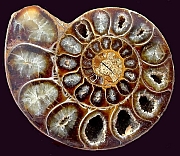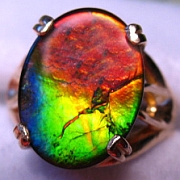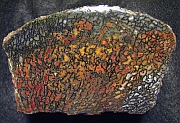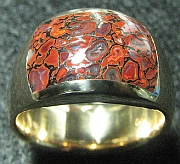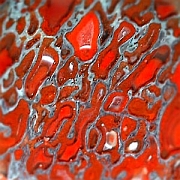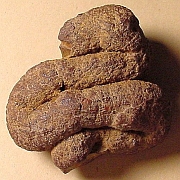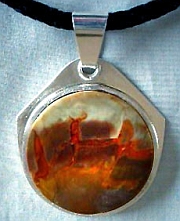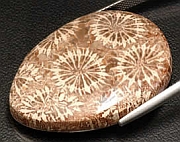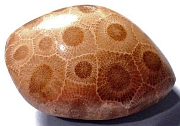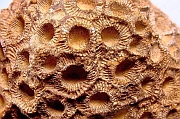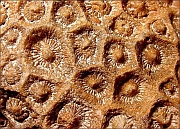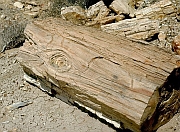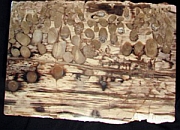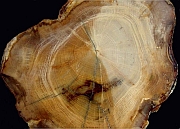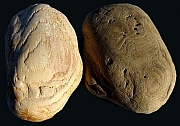Description Fossils are the remains of ancient organic organisms, including plants, shells, and animals. Many fossils were made from oranisms that are now extinct. Fossils were formed over millions of years, when the organic material of organisms were replaced with minerals, such as agate and opal. Only a few fossils are used as gemstones, cut, polished, set in gold or silver and worn as jewlery. Some of the most common fossils used as gemstones are ammonite, fossilized dinosaur bone, fossilized dinosaur dung, fossilized coral and petrified wood. Ammonite Ammonites are fossilized shells of an extinct species of cephalopod that lived during the Jurassic Period, about 150 million years ago. While ammonites look a lot like the modern nautilus shell, the ammonite's closest relative is actually the octopus! Ammonites range is size from about a centimeter to more than 2 meters in diameter, and they can be made of stone, agate, chalk or pyrite, though ammonites used as gemstones are usually made of agate. The shape of ammonites resemble the coiled horn of a ram. Ancient Roman naturalist Pliny the Elder (d. 79 A.D.) named ammonites ammonis cornua, meaning "horns of Ammon." Ammon was the Greek name for an Egyptian god that was symbolized by a ram. Ammon later became an important oracle for people of ancient Greece and Rome. Ammolite is a trade name for the fossilized nacre, or mother of pearl, portion of the ammolite shell. In some ammonites, the organic material is, over millions of years, replaced with agate, which is a very hard mineral. In comparison, ammolite is a soft gemstone, like pearl. In fact, ammolite and pearls are made of the same kind of material. Thus ammolite is very fragile, and is often sold in doublets or triplets, like opal. Arguably, ammolite is the rarest, most valuable gemstone in the world, worth more in weight than gold. Ammolite was formed during the Cretaceous Period, about 70 to 140 milion years ago, when a shallow, inland sea covered much of North American. Found along the eastern slopes of the Rocky Mountains in Northern America, ammolite deposits are primarily found in Alberta Canada. Ammolite is the official provincial gemstone of Alberta. Fossilized Dinosaur Bone text Fossilized Dinosaur Dung: Coprolite text Fossilized Coral Fossilized coral, also known as agatize coral, is not actually coral. Coral is made of a soft mineral called calcium carbonate. In fossilized coral, the calcium carbonate has, over millions of years, been replaced with agate. Agate is a very hard mineral that is much more durable than natural coral. Three US States have fossilized coral as a state symbol: Flordia, Michigan and West Virginia. Fossilized Coral of Florida Florida's state stone is agatized coral, which is actually a fossil that is made from many extinct species of ancient corals. Most of the agatized coral found in Florida today was formed from a wide variety of corals that lived during the Eocene Epoch, about 40 million years ago, when Florida and the Gulf Coast was covered by a vast warm sea. Fossilized Coral of Michigan: Petoskey stone Michigan's state stone, called Petosky Stone, is actually a variety of fossilized coral. Petosky Stone is made of a species of coral called Hexagonaria, which uses the root word hexagon (six-sided). Polished Petosky Stone shows a geometric pattern of shapes that are roughly six-sided. Petoskey Stones were formed during the Devonian Period, about 360 million years ago. During this period, Michigan and much of North America was covered by a shallow sea, in which coral reefs grew. Petosky Stones are actually fragments of this ancient coral reef. Today, Petoskey Stones may be found at Fisherman's Island State Park and at the south end of the beach at Petoskey State Park. Fossilized Coral of West Virginia West Virginia's state gem is a variety of fossilized coral made from an extinct species of coral called Lithostrotionella. This species of coral was formed during the Mississippian Period, about 340 million years ago, when a vast shallow sea covered most of what is now the United States. Lithostrotionella is found almost exclusively in the Hillsdale Limestone of Greenbrier and Pocahontas counties in the southeastern portion of West Virginia. Petrified Wood Petrified wood is not actually wood. Wood is an organic material made of carbon and other elements. In petrified wood, the organic material of wood has, over millions of years, been replaced with agate or opal. Usually petrified wood is made of agate, but where the petrified wood has formed in an area with an abundance of water, opal has sometimes replaced the original organic material. What is left is not wood at all but an inorganic mineral that looks just like wood. Six US States and a Canadian province have petrified wood as an official symbol: Arizona, Louisiana, Mississippi, North Dakota, Texas, Washington and Alberta Canada. Petrified Wood of Arizona Arizona's state fossil is a variety of petrified wood that is made from from an extinct species of confier called Araucarioxylon arizonicum. This species of petrified wood was formed during the Late Triassic Period about 200 million years ago, and it is found mainly in the region of the US that spreads across northern Arizona, Nevada, Utah, western New Mexico, and western Colorado. Petrified Wood of Louisiana, Mississippi and Texas all use petrified palmwood as a symbol of their states. Petrified palmwood is made of an extinct species of palm called Palmoxylon. This species of petrified palmwood was formed during the Oligocene epoch about 30 million years ago, and it is found in east Texas and western Louisiana, as well as many places around the world. Petrified Wood of North Dakota North Dakota's state fossil is a variety of petrified wood called Teredo Petrified Wood. Named for a genus of shipworm called Teredo, Teredo Petrified Wood shows distinctive markings, such as channels and bore holes, commonly made by shipworms. Today as in times past, shipworms wreak havoc on trees, wooden boats and dock posts. During the Paleocene Epoch, about 60 million years ago, North Dakota was partially covered by an ancient sea referred to as the Cannonball Sea. Many species of trees of this period, including bald cypress, ginkgo, redwood and magnolia, were attacked by shipworms before being washed into the Cannonball Sea, and the wood was fossilized, holes and all. Petrified Wood of Washington State Washington is the only US state to honor a fossil, petrified wood, as its state gemstone. Most of the petrified wood in Washington was formed during the Miocene Epoch, about 10 million years ago. While Washington is currently known as the Evergreen State, for its forests of evergreen and coniferous trees, during the Miocene Epoch Washington had a damp, mild climate that gave host to incredible forests filled with deciduous trees such as cypress, oak, beech, elm and ginkgo. These deciduous forests of ancient western Washington grew next to large volcanoes, and when the volcanoes erupted, tons of ash buried the trees, providing the perfect environment for petrification to occur. In the Ginkgo Petrified Forest State Park, there are many types of petrified wood, but the prevalence of ginkgo wood gives the park its name. Ginkgo trees, also called maidenhair trees, were thought to have gone extinct until living specimens were discovered in China in the last century. Petrified Wood of Alberta Canada Petrified wood is also Alberta's provincial stone. The petrified wood of Alberta was formed during the Cretaceous Period, about 90 million years ago, and may be found in gravel pits throughout the province. Symbolism US States: See www.statefossils.com for a list of states that have dinosaur fossils as their symbols. Canadian Province: |
|

